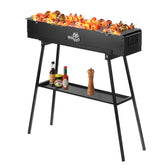The Art of American Barbecue: A Cultural Smoking Sensation
Introduction: In the heartland of American cuisine, barbecue stands as a testament to the nation’s culinary diversity and deep-seated traditions. More than just a method of cooking, barbecue is a cultural icon that has transcended generations, becoming a unifying force across the United States. In this blog post, we’ll dive into the smoky essence of American barbecue culture, exploring its history, regional nuances, and the craft behind its legendary flavors.
The Historical Smoke Signals: The roots of American barbecue can be traced back to the indigenous peoples of the Americas, who slow-cooked meats over open fires. European settlers, particularly those from the Caribbean and the South, adopted and adapted these techniques, infusing their own flavors and creating a distinctively American cooking style. Over time, barbecue became intertwined with the fabric of American life, from communal gatherings to competitive cooking events.
Regional Flavors and Rivalries: American barbecue is a patchwork of regional styles, each with its own proud heritage and unique approach to the craft. Here’s a tour of some of the most iconic barbecue regions:
Texas Barbecue: In the Lone Star State, barbecue is a sacred tradition. Texans specialize in smoking beef, with brisket being the crown jewel. The meat is cooked low and slow over indirect heat from post oak or mesquite, resulting in a tender and flavorful cut with a peppery bark.
Kansas City Barbecue: Known for its robust and spicy sauces, Kansas City barbecue is a melting pot of styles. Pitmasters here serve up everything from ribs and pulled pork to smoked chicken, all drenched in a thick, tomato-based sauce that packs a punch.
Carolina Barbecue: The Carolinas are all about pork, with whole hog barbecue being a staple. In North Carolina, the focus is on a vinegar-based sauce, while South Carolina favors a mustard-based condiment. Both styles emphasize the importance of smoking the meat to perfection.
Memphis Barbecue: Ribs are king in Memphis, where they are cooked in a dry rub and often served with a sweet and tangy sauce on the side. The city is also famous for its “pig and whistle” joints, where barbecue is enjoyed with a side of live blues music.
The Craft of Barbecue: Mastering the art of barbecue requires a blend of skill, patience, and passion. Here are some key elements that every pitmaster should consider:
Meat Selection: Choosing the right cut is crucial. Whether it’s pork shoulder for pulled pork or beef brisket, the quality and cut of the meat will significantly affect the outcome.
Smoking Techniques: The “low and slow” method is the golden rule of barbecue. Maintaining a consistent temperature and smoke level is essential for achieving that perfect balance of smoky flavor and tenderness.
Wood Selection: Different types of wood impart distinct flavors. Hickory offers a strong, bacon-like smokiness, while oak provides a milder smoke. Experimenting with wood varieties can lead to unique and memorable tastes.
Sauce and Rubs: The final layer of flavor comes from the sauce or dry rub. These can be as simple or complex as the chef’s imagination, often reflecting the regional preferences of the barbecue style.
Conclusion: American barbecue is a culinary journey that celebrates the rich heritage and diverse flavors of the nation. It’s a craft that requires dedication and respect for tradition, yet it’s always evolving, with pitmasters pushing the boundaries of flavor and technique. Whether you’re a seasoned smoker or a backyard beginner, embracing the art of American barbecue is a flavorful adventure that connects us all through the universal language of good food. So fire up the smoker, and let the smoky saga continue.












